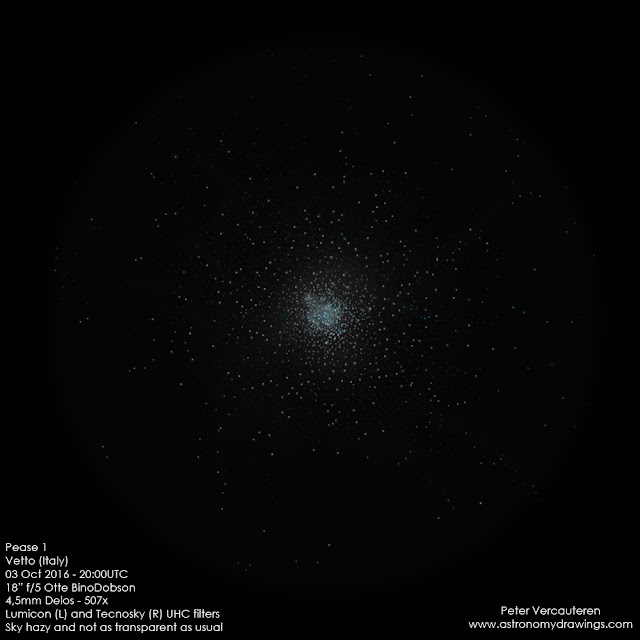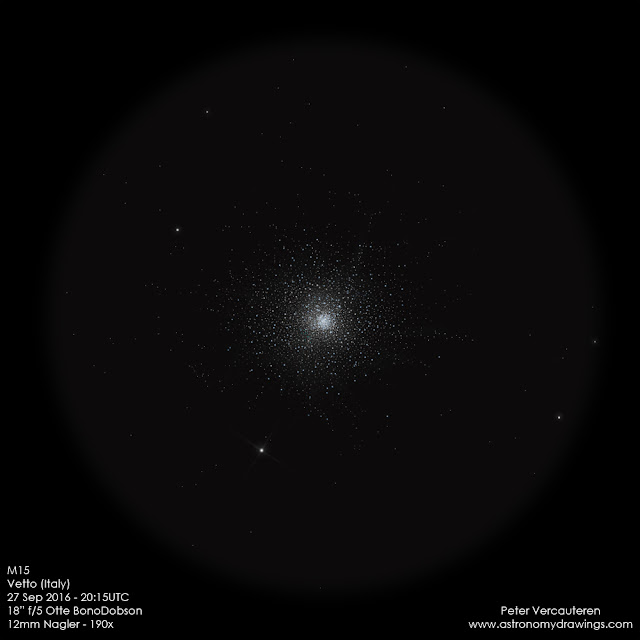Almost a year ago I wrote about
M33, the famous Triangulum Galaxy. The sketch I presented at the time was observed through my 100mm astronomical binoculars, which is in fact one of the best instruments to use on this object. The galaxy spans an area of almost 4 full moons in our sky, meaning that its light's dispersed over a large area. Therefore it appears very faint and doesn't support high magnifications well. An ordinary pair of binoculars, on the other hand, has a relatively low magnification compared to the combined aperture of its lenses and will show the galaxy as a small but reasonably bright smudge. Remember what I told you about magnification! Suppose the total amount of light a telescope can capture of an object is one of these mini jars of jam you get in a hotel. When you spread the jam on one slice of bread (small surface - low magnification), you will taste the jam quite well. But when you spread it on a whole loaf (large surface - high magnification), its taste will hardly be noticeable.
A telescope often struggles with these large and extremely faint objects and with good reason too. The main job of a telescope is not to magnify, as many people think, but to capture as much light as possible, concentrate it and let it all fit into your eye. The bigger the lens or mirror of a telescope, the more light it can capture and the better you'll see the object. But... every telescope also has a minimum magnification which is directly related to the size of its lens or mirror. If you go lower, not all of the light that the telescope captures will enter your eye anymore because its "exit pupil" will be too large. The "exit pupil" is the little image disk that comes out of the telescope and which you can observe. If this disk's larger that the pupil of your eye, some of its light will be lost and this would be the same as looking through a smaller telescope. If we suppose that the pupil of a young person can open up to 7mm in the total dark, a telescope with an 18" mirror has a minimum magnification of 65x. Below that, the "exit pupil" will be larger than 7mm and hence be larger than the pupil of your eye. An 8" telescope, on the other hand, can go as low as 28x, or 2,3 times less than the 18" telescope. At 28x the object will appear 2,3x smaller but also 2,3x brighter than at 65x. Of course, an 18" telescope gathers 5 times more light than an 8" telescope so it still holds the advantage over its smaller brother.
Now let's talk about a binoscope. In theory, its combined optical tubes gather as much light as a telescope of 1,41 times its diameter. An 8" binoscope therefore has the same performance as an 11,3" monocular telescope. But... with the 8" binoscope you can go as low as 28x, whereas the 11,3" telescope has a minimum magnification of 41x! This is one of the biggest advantages of the binoscope: the same light gathering power and optical resolution as a much bigger monocular telescope, but with a much lower minimum magnification.
If you want to know what this means for our large and faint galaxy, here's my sketch of M33 through my 18" binoscope:
Not only did I see the spiral arms in a way that I've never seen before, many bright star forming regions in the galaxy really stood out. Here's the sketch with labels:
In my next blog post I'll take you a bit closer...































